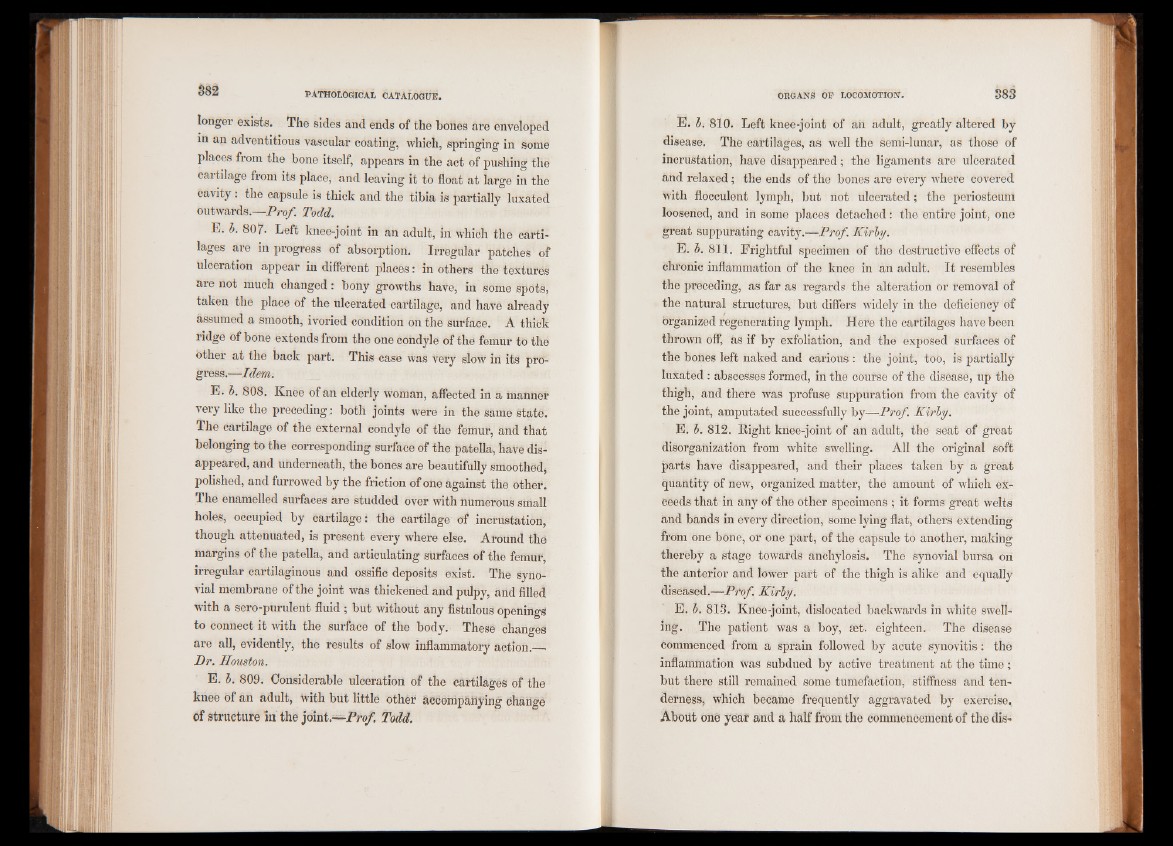
longer exists. The sides and ends of the bones are enveloped
in an adventitious vascular coating, which, springing in some
places from the bone itself, appears in the act of pushing the
cartilage from its place, and leaving it to float at large in the
cavity: the capsule is thick and the tibia is partially luxated
outwards.—Prof. Todd.
Ei b. 807- Left knee-joint in an adult, in which the cartilages
are in progress of absorption. Irregular patches of
ulceration appear in different places: in others the textures
are not much changed: bony growths have, in some spots,
taken the place of the ulcerated cartilage, and have already
assumed a smooth, ivoried condition on the surface. A thick
ridge of bone extends from the one condyle of the femur to the
other at the back part. This case was very slow in its progress.—
Idem.
E. b. 808. Knee of an elderly woman, affected in a manner
very like the preceding; both joints were in the same state.
The cartilage of the external condyle of the femur, and that
belonging to the corresponding surface of the patella, havé disappeared,
and underneath, the bones are beautifully smoothed,
polished, and furrowed by the friction of one against the other.
The enamelled surfaces are studded over with numerous small
holes, occupied by cartilage; the cartilage of incrustation,
though attenuated, is present every where else. Around the
margins of the patella, and articulating surfaces of the femur,
irregular cartilaginous and ossific deposits exist. The Synovial
membrane of the joint was thickened and pulpy, and filled
with a sero-purulent fluid; but without any fistulous openings
to connect it with the surface of the body. These changes
are all, evidently, the results of slow inflammatory action.—
Dr. Houston.
E. b. 809. Considerable ulceration of the cartilages of the
knee Of an adult, with but little other accompanying change
of structure in the joint.—Prof. Todd.
E. b. 810. Left knee-joint of an adult, greatly altered by
disease. The cartilages, as well the semi-lunar, as those of
incrustation, have disappeared; the ligaments are ulcerated
and relaxed; the ends of the bones are every where covered
with flocculent lymph, but not ulcerated; the periosteum
loosened, and in some places detached: the entire joint, one
great suppurating cavity.—Prof. Kirby.
E. b. 811. Frightful specimen of the destructive effects of
Chronic inflammation of the knee in an adult. It resembles
the preceding, as far as regards the alteration or removal of
the natural structures, but differs widely in the deficiency of
Organized regenerating lymph. Here the cartilages have been
thrown off, as if by exfoliation, and the exposed surfaces of
the bodes left naked and carious : the joint, too, is partially
luxated: abscesses formed, in the course of the disease, up the
thigh, and there was profuse suppuration from the cavity of
the joint, amputated successfully by—Prof. Kirby.
E. b. 8l 2. Eight knee-joint of an adult, the seat of great
disorganization from white swelling. All the original soft
parts have disappeared, and their places taken by a great
quantity of new, organized matter, the amount of which exceeds
that in any of the other specimens ; it forms great welts
find bands in every direction, some lying flat, others extending
from one bone, or one part, of the capsule to another, making
thereby a stage towards anchylosis. The synovial bursa on
the anterior and lower part of the thigh is alike and equally
diseased.—Prof. Kirby.
E. b. 813. Knee-joint, dislocated backwards in white swelling.
The patient was a boy, set. eighteen. The disease
Commenced from a sprain followed by acute synovitis: the
inflammation was subdued by active treatment at the time;
but there still remained some tumefaction, stiffness and tenderness,
which became frequently aggravated by exercise.
About one year and a half from the commencement of the dis